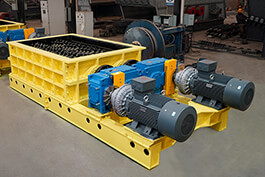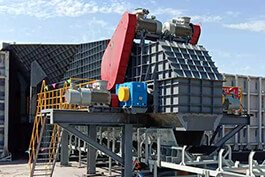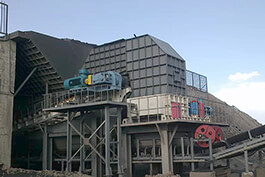Introduction
In continuous mining and material handling systems, the Feeder Breaker connects the mining system with the material handling system, is responsible for continuous feeding and crushing, is highly efficient in performance, and can handle wet, dry and sticky materials.
Before the material flow enters the feeder breaker crushing chamber, the pre-screening classifies the particle size of the material, screens out the small-sized materials, improves the crushing efficiency and reduces the generation of powder.
Pre-Screening
Dynamic and static pre-screening
Pre-screening can be divided into dynamic pre-screening and static pre-screening. There are significant differences between them in structural design, screening principles and applicable scenarios. It is necessary to make targeted configurations based on specific working conditions (such as material characteristics, particle size requirements, processing capacity and humidity of the working environment, etc.).
Static pre-screening, with its advantages of simple structure and high reliability, is suitable for handling scenarios with large pieces, low viscosity and low impurity content of materials.
Dynamic pre-screening enhances screening efficiency through active disturbance and is more suitable for handling materials with a high proportion of fine particles, strong viscosity or prone to caking.
Benefits
The core screening component of the receiving section is the static screening grate, which is made of high-strength wear-resistant steel. The spacing of the grate bars is preset according to the large particle materials in the receiving section. When the raw ore falls into the receiving section from the feeding port, the static screening grate can withstand the impact of large pieces of materials weighing several tons without displacement or deformation. While achieving the initial particle size classification, it also reduces the processing pressure for the subsequent dynamic screening process.
The non-material receiving section adopts a dynamic screening method. A specially designed sinusoidal disturbance screen is integrated on the conveyor box, which is suitable for the screening of small particles and viscous materials. The non-receiving section adopts the sinusoidal interference screening method to prevent the material from getting stuck.
After the materials are pre-screened and crushed, excessive crushing can be avoided, the generation of powder can be reduced, the output of ore blocks can be maximized, and the economic benefits and value of the end users can be improved.

The design of Feeder breaker
Structural analysis
The feeding and conveying module of the Feeder Breaker, the common chain plate type and scraper type, conveys the material to Crushing Unit. Youdaoplaceholder0 Unit is responsible for reducing the particle size of the material. The pre-screening area is set on the feeding and conveying module.
In some large-scale mines' Feeder Breakers, the feeding conveyor adopts a chain plate structure, and the gaps between the chain plates form the key areas for pre-screening. When the materials move on the chain plates, fine materials smaller than the gap size will naturally fall, achieving initial screening. In some other application scenarios, integrated screening structures are more common. They may include special screening plates installed on the deck of the feeding conveyor. The shape and size of the sieve holes on these plates are customized according to the material characteristics and production requirements, enabling more precise particle size classification of the materials.
Screening mechanism
During the pre-screening process, fixed bar/grid and chain plate gap screening are two main screening mechanisms.
Fixed bars/grilles are usually located below the feeding inlet and consist of a series of parallel bars or grilles. The size of the gap between the bars determines the particle size of the material that can pass through, which can keep branches, iron blocks and other debris out, ensuring the cleanliness and safety inside the crusher.
Dynamic screening makes full use of the structural features of the chain plate conveyor. When materials move on the chain plate conveyor, the designed gap between the chain plates becomes the key to screening. As the materials are continuously conveyed, fine materials smaller than the gap between the chain plates will fall from the gap under the action of gravity and material movement, achieving continuous dynamic screening.
Particle size control
If the screening cut-off particle size is set too high, it will cause some materials that should be crushed to bypass the crushing drum and enter the subsequent process, affecting the particle size quality of the product. On the contrary, if the setting is too small, too much material will enter the crushing chamber, increasing the load on the crusher and reducing production efficiency.
According to the model of the crusher and production requirements, it is more appropriate to set the screening cut-off particle size at 80% - 90% of the minimum discharge port size of the crusher. This can not only ensure that the materials bypassed have met the particle size requirements, but also guarantee the effective operation of the crusher.
The benefits of pre-screening
Energy consumption optimization
The raw ore materials entering the system are precisely classified by particle size through pre-screening. The fine materials that have met the requirements of the subsequent production process will be efficiently separated from the main material flow in advance and enter the belt conveyor below, without the need to enter the crushing module to participate in the crushing operation. This avoids the waste of resources and energy caused by qualified fine materials entering the crushing process from the source.
Reduced wear
During the crushing process, the material frequently comes into contact with the crushing teeth, and the high-speed moving material exerts a strong frictional force on the surface of the crushing teeth. The impact of materials can also cause damage to the crushing teeth, especially the impact of large pieces of materials, which may lead to cracks or even breakage of the crushing teeth. Through pre-screening, a large amount of fine materials are separated in advance, reducing the amount of material entering the crushing chamber and thereby alleviating the load on the crushing components. The number of cycles for fine materials has also been greatly reduced. Without pre-screening, fine materials may circulate multiple times in the crushing chamber, repeatedly rubbing and impacting the crushing components, which intensifies wear.
Improve the downstream material flow
After the material undergoes pre-screening, its particle size distribution becomes more uniform, avoiding the situation where large pieces or fine powder are concentrated and flood into the downstream belt conveyor system. If there is no pre-screening, large pieces of material may suddenly enter the belt, causing a huge impact load on the belt and leading to belt damage or deviation. If fine powder rushes in in a concentrated manner, it may cause blockage in the belt conveyor system and affect production efficiency. Pre-screening, by separating fine materials in advance and controlling the particle size of the materials, makes the materials entering the belt conveyor system more stable and uniform.
Conclusion
The pre-screening of Feeder breaker optimizes energy consumption, reduces the specific energy consumption of the system, and enables more rational utilization of energy. It reduces the wear of the crushing components, extends the service life of the equipment and lowers the maintenance cost. The effective processing capacity of the crusher has been increased and the production capacity has been enhanced. The downstream material flow has been improved, ensuring the stable operation of the entire production system.






.jpg)






